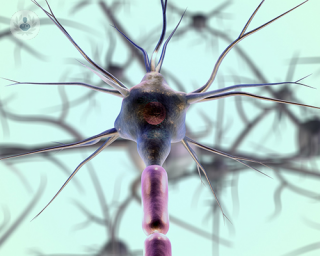What is pain management?
Pain management is an interdisciplinary branch of medicine, which aims to improve quality of life for patients with chronic pain by reducing their suffering. It aims to relieve long-term pain, and may be administered by a single doctor, or a pain management team, consisting of different specialists. It can involve pharmacological or psychological treatments, or a combination of both.

Why would you need pain management?
While many branches of medicine focus on diagnosing and treating injuries and pathologies and treating the symptoms and pain during the healing process, pain management is needed when the pain persists after the injury or disease has healed. If the cause of the pain is not clear, relieving it becomes the objective. Patients with chronic (long-term) pain are the usual recipients. Types of pain that often require management include chronic back pain and headaches.
What does it involve?
There are many types of treatments to manage pain, which can be roughly divided into three categories: physical, psychological, and medicinal.
Physical treatments include physiotherapy, therapeutic physical exercise, the application of heat and/or ice, acupuncture, electrotherapy, and various interventional procedures, such as facet joint injections and spinal cord stimulation. Different sufferers may find different things help relieve their pain, such as massage therapy. Some treatments may have a psychological element, including the placebo effect.
Psychological treatments, such as cognitive behavioural therapy (CBT) and hypnosis have been used to treat pain, with varying reports on the efficacy. Studies have shown a small improvement in mood after CBT, but there is insufficient evidence to definitively say that it relieves pain. Similarly, studies on the effects of hypnosis have been limited, but shows signs of improvement. Some believe it the effectiveness of psychological treatments may be based on the placebo effect.
Medicinal treatments involves different kinds of drugs – mainly painkillers and anti-inflammatories. The type of drug depends on the location, severity, and probable cause of the pain. For example, mild pain can be managed with over-the-counter painkillers, while severe pain (after injury or surgery, for example) may be treated with opioids. Nonsteroidal anti-inflammatory drugs (NSAIDs) are widely used, and for conditions like fibromyalgia, antidepressants may be prescribed.
Due to the multi-disciplinary nature of the specialty, a pain management team can consist of medical practitioners, nurse practitioners, physiotherapists, psychologists, and other mental health therapists.
11-13-2012 01-26-2024Pain treatment
What is pain management?
Pain management is an interdisciplinary branch of medicine, which aims to improve quality of life for patients with chronic pain by reducing their suffering. It aims to relieve long-term pain, and may be administered by a single doctor, or a pain management team, consisting of different specialists. It can involve pharmacological or psychological treatments, or a combination of both.

Why would you need pain management?
While many branches of medicine focus on diagnosing and treating injuries and pathologies and treating the symptoms and pain during the healing process, pain management is needed when the pain persists after the injury or disease has healed. If the cause of the pain is not clear, relieving it becomes the objective. Patients with chronic (long-term) pain are the usual recipients. Types of pain that often require management include chronic back pain and headaches.
What does it involve?
There are many types of treatments to manage pain, which can be roughly divided into three categories: physical, psychological, and medicinal.
Physical treatments include physiotherapy, therapeutic physical exercise, the application of heat and/or ice, acupuncture, electrotherapy, and various interventional procedures, such as facet joint injections and spinal cord stimulation. Different sufferers may find different things help relieve their pain, such as massage therapy. Some treatments may have a psychological element, including the placebo effect.
Psychological treatments, such as cognitive behavioural therapy (CBT) and hypnosis have been used to treat pain, with varying reports on the efficacy. Studies have shown a small improvement in mood after CBT, but there is insufficient evidence to definitively say that it relieves pain. Similarly, studies on the effects of hypnosis have been limited, but shows signs of improvement. Some believe it the effectiveness of psychological treatments may be based on the placebo effect.
Medicinal treatments involves different kinds of drugs – mainly painkillers and anti-inflammatories. The type of drug depends on the location, severity, and probable cause of the pain. For example, mild pain can be managed with over-the-counter painkillers, while severe pain (after injury or surgery, for example) may be treated with opioids. Nonsteroidal anti-inflammatory drugs (NSAIDs) are widely used, and for conditions like fibromyalgia, antidepressants may be prescribed.
Due to the multi-disciplinary nature of the specialty, a pain management team can consist of medical practitioners, nurse practitioners, physiotherapists, psychologists, and other mental health therapists.


What are the benefits of radiofrequency neurotomy?
By Dr Ralph Rogers
2025-01-28
In his latest online article, highly experienced sports medicine specialist Dr Ralph Rogers explains the incredible pain-relieving benefits of radiofrequency neurotomy. He delves into how this treatment works, what the procedure entails and the results patients can expect. See more


Expert advice on selecting a regenerative medicine specialist
By Dr Martynas Juozaitis
2025-01-28
Regenerative medicine is at the cutting edge of treatment for degenerative conditions and musculoskeletal injuries but advanced specialist expertise is required to administer it correctly. In this expert guide to choosing a regenerative medicine specialist, leading consultant in anaesthesia and pain medicine Dr Martynas Juozaitis outlines the questions patients can ask to ensure their treatment will be both safe and effective. See more


Botox for pain relief: How does it work?
By Dr Husham Al-Shather
2025-01-28
Although Botox is commonly known for its use in anti-ageing treatments, there are many beneficial applications of this form of treatment. In this informative article, highly respected advanced cosmetic doctor and consultant specialist in pain medicine Dr Husham Al-Shather explains how Botox is used as a highly effective, minimally invasive treatment for some types of chronic pain. See more


Complementary therapy for pain – worth a try?
By Dr Dhiya Houssien
2025-01-28
It seems to be a growing trend in the UK - seeing an osteopath or acupuncture specialist to treat chronic pain. So why are people turning to complementary therapy? And can it live up to the promise it makes? Leading consultant rheumatologist Dr Dhiya Houssien tells us all about it. See more
Experts in Pain treatment
-
Dr Clarissa Pilkington
RheumatologyExpert in:
- Juvenile arthritis
- Lupus
- Dermatomyositis
- Hypermobility
- Pain treatment
- Paediatric rheumatology
-
Dr Andrew Nicolaou
Pain medicineExpert in:
- Back pain
- Neck pain
- Neuropathic pain
- Pain treatment
- Chronic pain
- Musculoskeletal pain
-
Dr Yasser Mehrez
Pain medicineExpert in:
- Epidural infiltration
- Pain treatment
- Radiofrequency treatment (RFA)
- Back pain
- Chronic pain
- Fibromyalgia
-
Dr Martynas Juozaitis
Pain medicineExpert in:
- Pain treatment
- Musculoskeletal pain
- Stem cells
- Platelet-rich plasma
- Knee
- Joint pain
-
Dr Federica Boecklin
Healthcare professionalsExpert in:
- Integrative medicine
- Homeopathy
- Acupuncture
- Stress
- Pain treatment
- Preventive medicine
- See all

The Saxon Clinic - part of Circle Health Group
The Saxon Clinic - part of Circle Health Group
V7 Saxon St, Coffee Hall, Milton Keynes MK6 5LR
No existe teléfono en el centro.
By using the telephone number provided by TOP DOCTORS, you automatically agree to let us use your phone number for statistical and commercial purposes. For further information, read our Privacy Policy
Top Doctors

The Portland Hospital - part of HCA Healthcare
The Portland Hospital - part of HCA Healthcare
205 - 209 Great Portland St. W1W 5AH
No existe teléfono en el centro.
By using the telephone number provided by TOP DOCTORS, you automatically agree to let us use your phone number for statistical and commercial purposes. For further information, read our Privacy Policy
Top Doctors

Great Ormond Street Hospital
Great Ormond Street Hospital
Great Ormond Street. WC1N 3JH
No existe teléfono en el centro.
By using the telephone number provided by TOP DOCTORS, you automatically agree to let us use your phone number for statistical and commercial purposes. For further information, read our Privacy Policy
Top Doctors
-
The Saxon Clinic - part of Circle Health Group
V7 Saxon St, Coffee Hall, Milton Keynes MK6 5LR, Milton KeynesExpert in:
- General Surgery
- Orthopaedic surgery
- Gastroenterology
- Obstetrics and Gynaecology
- Paediatrics
- Urology
-
The Portland Hospital - part of HCA Healthcare
205 - 209 Great Portland St. W1W 5AH, Central LondonExpert in:
- Neurological spinal surgery
- Orthopaedic spinal surgery
- Maternity care
- Pregnancy
- Scoliosis
- In vitro fertilisation (IVF)
-
Great Ormond Street Hospital
Great Ormond Street. WC1N 3JH, Central LondonExpert in:
- Cancer
- Paediatric neurosurgery
- Paediatrics
- See all
- Most viewed diseases, medical tests, and treatments
- Osteoporosis
- Trigeminal neuralgia
- Visual impairment
- Diabetic retinopathy
- Retina
- Visual stress (Meares-Irlen syndrome)
- Presbyopia
- Nystagmus
- Myopia
- Hyperopia (farsightedness)







